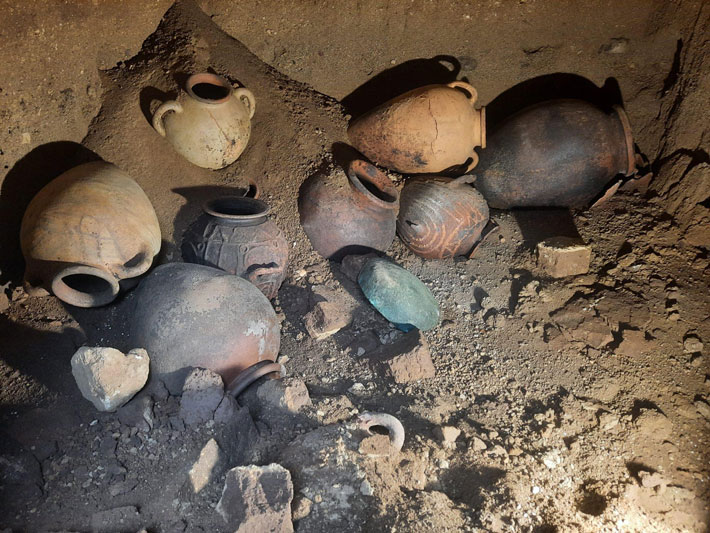Discovery of an Untouched Etruscan Tomb
In April, archaeologists made a groundbreaking discovery within the Vulci Archaeological Park in central Italy—an untouched, two-chambered Etruscan tomb that had been sealed for 2,600 years. This tomb, unearthed in near-perfect condition, presents a remarkable opportunity to study the ancient Etruscan civilization’s funeral traditions, societal structure, and craftsmanship.

The tomb’s undisturbed nature offers a rare snapshot of the Etruscan way of life, revealing not just burial customs, but also the artistry and wealth of the period. Such finds are invaluable for historians and archaeologists, providing physical evidence of Etruscan culture which has long fascinated scholars due to its significant, yet somewhat mysterious, influence on early Roman society.
Rich Array of Artifacts
Inside the tomb, a wide range of pottery, amphorae, tools, cups, and a bronze cauldron were found in exceptional condition. These artifacts suggest that the deceased was someone of high status, possibly a member of the aristocratic class of Vulci, one of the most prominent cities in the Etruscan league. The inclusion of these items in the burial chamber demonstrates the Etruscan belief in equipping the dead with essential goods for their journey to the afterlife.

The objects reflect both the Etruscans’ everyday life and their spiritual practices. For instance, the presence of amphorae (which were often used to store wine and oil) and the bronze cauldron likely points to the importance of feasting, both in life and death. Such items may have had a dual purpose—used during the deceased’s life and then interred as offerings in the afterlife, underscoring the Etruscans’ belief in the continuation of existence beyond death.
The “Last Meal” Ritual and the Sacred Tablecloth
One of the most intriguing discoveries within the tomb is a ceremonial tablecloth believed to have been used in the sacred Etruscan ritual of the “last meal.” In this funerary rite, food was burned inside the tomb as an offering to the gods, before the burial of the body. This tablecloth, remarkably preserved, likely covered a surface where offerings were prepared or served. Its presence sheds light on the Etruscan practice of honoring the dead with elaborate feasts, a custom that emphasized the sacred bond between the living and the deceased.

This ritual practice not only involved food offerings but also symbolized the transition from life to death. By burning food inside the tomb, the Etruscans believed they were aiding the deceased in their passage to the afterlife. The well-preserved nature of these relics, particularly the ceremonial tablecloth, provides a vivid image of the spiritual life of the Etruscans, offering deeper insight into their religious practices.
The Importance of Vulci and Etruscan Society
The tomb’s location within Vulci, a key Etruscan city, further amplifies the significance of this find. Vulci was a major cultural and political hub of ancient Etruria, known for its thriving aristocracy, trade networks, and craftsmanship. Many elite Etruscan families were buried in elaborate tombs such as this one, often accompanied by valuable grave goods to reflect their wealth and status.

The structure of the two-chambered tomb also offers clues about the social hierarchy of the Etruscan civilization. These types of tombs were often reserved for individuals of noble birth, suggesting that the person interred within this tomb was likely a figure of considerable influence. The grandeur of the burial site, combined with the array of treasures inside, points to a society that placed great emphasis on honoring the dead and ensuring their safe passage into the afterlife.
Insights into Etruscan Culture and Influence
The discovery of this tomb not only highlights the Etruscans’ religious beliefs and funerary practices, but also their mastery in metalwork and pottery, as evidenced by the intricate craftsmanship of the items found within the tomb. The bronze cauldron, for example, showcases the advanced metalworking skills of the Etruscans, while the amphorae and cups provide further proof of their refined pottery techniques.
Moreover, the tomb’s treasures reveal the cultural exchanges between the Etruscans and neighboring civilizations, such as the Greeks and early Romans. As a civilization located in the heart of the Mediterranean, the Etruscans were well-positioned to engage in trade and cultural exchange, which influenced their art, religion, and social structure. The discovery of these artifacts offers a tangible link to these interactions and helps clarify the role the Etruscans played in shaping the early Roman world.
Conclusion: A Window into Etruscan Life and Legacy
The intact Etruscan tomb unearthed in the Vulci Archaeological Park is a major discovery that provides invaluable insights into the Etruscan way of life, their religious practices, and their craftsmanship. As researchers continue to analyze the artifacts found within, this discovery is expected to deepen our understanding of the Etruscans’ role in Mediterranean history and their enduring legacy.
The tomb, with its array of well-preserved treasures, offers a rare glimpse into an ancient civilization that played a crucial role in the development of Roman culture. The Vulci tomb stands as a testament to the rich cultural tapestry of the Etruscans, a civilization whose influence can still be felt today.

